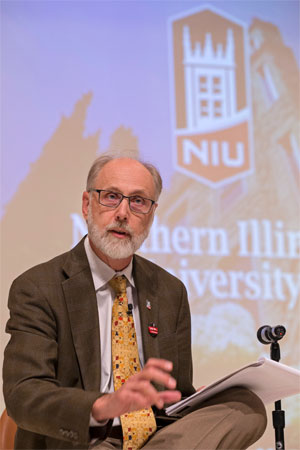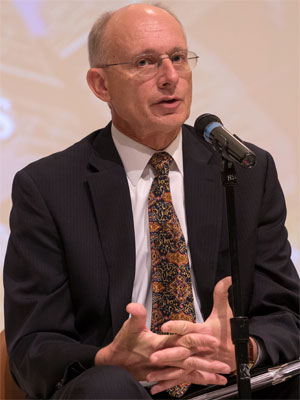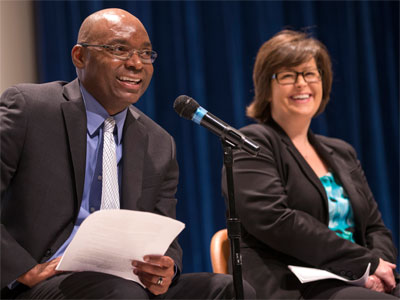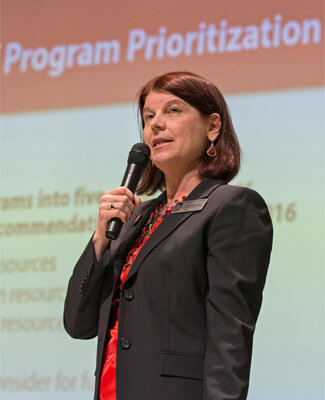President Doug Baker and a team of Northern Illinois University’s senior leaders delivered an upbeat message during a town hall meeting Wednesday afternoon in the Carl Sandburg Auditorium.
Despite challenging times, they said, things are looking up.
“There are a lot of universities that would love to be in the position that we’re in,” Baker said. “I’m here to tell you that we’re going to get through this, and we’ll be bigger and better on the other side.”
The session touched upon issues ranging from budgeting, to increasing enrollment, to international agreements that will increase diversity on campus to program prioritization.
It also included an open question-and-answer session.
One audience member asked Baker, in light of the budget impasse in Springfield, how long the university will be able to meet its payroll. He responded that leadership is confident that NIU will make it through the academic year, even if the legislature fails to agree on a budget during that time – a circumstance that he considered highly unlikely.
When asked about the outlook for pay increases, Baker said that finding money to better compensate employees is a priority, but one that is dependent upon circumstances. “Last year, not furloughing anyone was a priority,” Baker said, noting that the university had to find ways to plug a $15 million hole in its budget picture, and did so without layoffs.
Going forward, he said, the chances of a pay increase hinge largely upon how much funding the university receives from the state, how much we enhance our enrollments and how well we control our expenses. There has been discussion of what shape such a plan might take, he said, and current thinking is that any increase would likely be weighted more heavily toward those on the lower end of the pay scale.
In addition to Baker, four members of the university’s leadership team provided updates on specific areas:
Al Phillips, Vice President of Administration and Finance
Phillips touched upon the difficult financial situation in which the university is functioning.
By now, he said, the university should have long since known what its appropriation would be and be developing, or even implementing, spending plans. Even so, he sounded a tone of guarded optimism.
“We are looking at this as a bridge year,” Phillips said. “We will get through this.”
Phillips outlined four areas of emphasis for his division going forward.
The first was to control spending. Currently, he said, the university spends about $110 million a year on goods and services. A 10 percent reduction in those costs, he said, would yield $10 million in savings that could be used for other purposes, such as paying salaries.
Increasing efficiencies by improving processes will be another point of emphasis. For example, Phillips said, his division is creating a new office to streamline the process of getting a contract approved – something that currently takes up to 74 separate steps.
“The goal is to find ways to save costs and resources while cutting down on the frustration as we work through our challenges,” he said.
Phillips also said his division is working to implement a five-year budget cycle so that departments can plan into the future, rather than year to year, while also looking for ways to increase university revenues that extend beyond tuition and fees.
Eric Weldy, Vice President for Student Affairs and Enrollment Management
Weldy reviewed numerous changes within his division during the past two years, all designed to improve how well the university attracts and retains students.
In particular, he described the two-day orientation process implemented this summer for incoming students and their families.
“It gives us more time to show case our campus and its resources and it allowed students and their families to build closer connections to campus,” he said.
Moving forward, he said, the goal is to turn NIU’s enrollment management area into one of the best nation.
Dani Rollins, Director of Admissions
As the sixth director of admissions in the past six years, Rollins praised her staff, which has remained intact throughout those changes. Providing those individuals with training and support has been a key to helping her implement changes that she believes are starting to turn the tide of declining enrollment numbers for the last several years.
Among those initiatives have been efforts, working with the NIU Division of Marketing and Communications, to revitalize all of the print publications that her department shares with students. “We became over-reliant upon email and other electronic communications with potential students and their families. They still like to get a piece of paper in their hands, especially when it is first-generation college students,” Rollins said.
Lisa Freeman, Executive Vice President and Provost
Freeman updated the audience on the Program Prioritization process.
A lot of the groundwork for that process has been laid over the past year as various working groups and shared governance committees collaborated to develop evaluation criteria, process elements and task force membership, she said.
This fall, program experts will author narratives for all programs under review, which will then be handed over to the task forces in the spring.
Those groups will analyze programs using institutional data and submitted narratives in the context of the adopted criteria, and make recommendations regarding resource allocation to the reviewed programs. These recommendations will be used to inform the university’s budget process, as well as to inspire programs to pursue opportunities to enhance quality and increase efficiency.
“The feedback from this process will inform the budgeting process and allow us to align our resources with the things that really matter,” Freeman said.
Freeman said the Program Prioritization website is a key resource for information about the status of the effort, including information on the programs being evaluated, times and dates for training for those writing program narratives, and a source for answers to frequently asked questions.
Faculty and staff also can use the website to ask specific questions that might not be in the FAQs.




